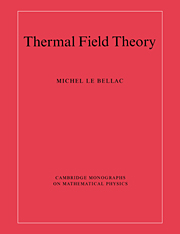Book contents
- Frontmatter
- Contents
- Preface
- 1 Introduction
- 2 Quantum statistical mechanics
- 3 The scalar field at finite temperature
- 4 Simple applications of perturbation theory
- 5 Dirac and gauge fields at finite temperature
- 6 Collective excitations in a plasma
- 7 Hard thermal loops and resummation
- 8 Dynamical screening
- 9 Neutrino emission from stars
- 10 Infrared problems at finite temperature
- A Formulary
- B Operator formalism
- References
- Index
1 - Introduction
Published online by Cambridge University Press: 05 May 2010
- Frontmatter
- Contents
- Preface
- 1 Introduction
- 2 Quantum statistical mechanics
- 3 The scalar field at finite temperature
- 4 Simple applications of perturbation theory
- 5 Dirac and gauge fields at finite temperature
- 6 Collective excitations in a plasma
- 7 Hard thermal loops and resummation
- 8 Dynamical screening
- 9 Neutrino emission from stars
- 10 Infrared problems at finite temperature
- A Formulary
- B Operator formalism
- References
- Index
Summary
Quantum chromodynamics
Most high-energy physicists will readily agree that quantum chromodynamics (QCD) is today the well-established theory of strong interactions; at least it has no serious competitor. Quantum chromodynamics is a non-Abelian gauge field theory whose gauge group is the colour group SU(3); it will sometimes be convenient to let the number of colours vary, and to take SU(N) as the gauge group: then the number of colours is N. There are (N2 − 1) = 8 gauge bosons, called gluons, and the matter particles are spin ½ quarks. There are six families of quarks, or six different flavours: up, down, strange, charm, beauty and top. The number of flavours will be denoted by Nf. The last three quarks are heavy and will not play any role at all in the development of this book because their mass is much larger than the characteristic energy scale of a few hundred MeV that we are interested in, while the role of the strange quark will be intermediate. The up and down quarks will often be taken as massless since their mass, of the order of a few MeV, is much smaller than our characteristic energy scale. Note that we use a system of units where ħ = c = KB = 1, where ħ, c and KB are, respectively, the Planck constant, the speed of light and the Boltzmann constant. Masses and temperatures will be often measured in MeV or GeV, lengths and times in MeV−1 or GeV−1.
- Type
- Chapter
- Information
- Thermal Field Theory , pp. 1 - 17Publisher: Cambridge University PressPrint publication year: 1996
- 1
- Cited by



